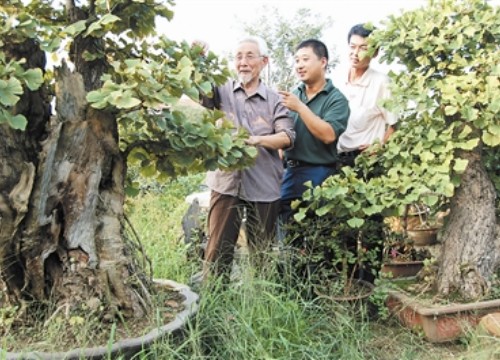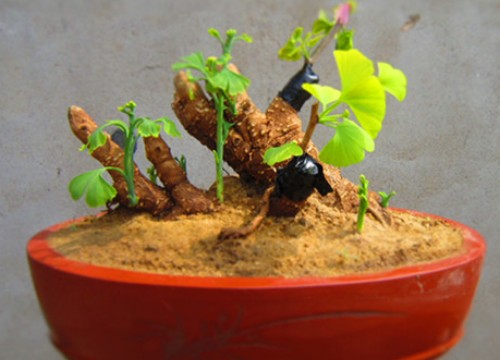Pruning method of bonsai of ginkgo trees
Pruning is one of the main techniques for making ginkgo bonsai. The purpose is to highlight the trunk, enrich the ornamental branches, express different artistic conceptions, improve the artistic value, and make it natural and simple, elegant and elegant. The principle is to cut off redundant side branches, parallel branches, cross branches, overdense branches, overgrown branches and diseased branches.

There are three basic techniques of pruning, that is, short cutting, thinning and shrinking. The short shears will cut the branches short, stimulate the lateral buds under the clipping mouth to germinate, form strong lateral branches, and have a tufted tendency, which is convenient for modeling, and often germinate secondary buds after cutting, increasing the number of branches. The purpose of pruning the trunk is to control the height of the tree and promote the development of lateral branches. The short cutting of the lateral branches is to promote the germination of hidden buds. To cut off the branches from the base.
The main objects are dead branches, disease and insect branches and redundant branches and over-dense branches which are not suitable for modeling, so that the remaining branches can get sufficient nutrients and grow healthily. Shearing is about to cut off part of the branches. It can reduce the size of root tillering seedlings or seedlings, which is beneficial to survival, and can also promote the germination of new branches and restore the tree potential of the aging pile head.
The purpose of pruning is to highlight the trunk, enrich the ornamental branches and improve the artistic value. The principle of pruning is to cut off excess side branches, parallel branches, cross branches, over-dense branches, only growing branches, and diseased branches.
The first year is the basis for the cultivation of pile heads. Strong branches grow fast in summer and can be shrunk on two branches. The secondary branches arising from pruning stimulation should be cut off in time. New branches born in late summer and early autumn can be retained. After defoliation in winter and before sprouting in the second year, all redundant branches such as whorled branches, cross branches and overgrown branches should be cut off. The sprouting strips growing at the root of the pile should be cut off in time.
The second year was to tie up the wire and split it to make a scar. When entangling, it is necessary to prevent the branch and stem production from breaking and tearing. If the base of the trunk is relatively hard, apply hemp rope and plastic tape from the base of the trunk to prevent tearing in the bending. You can also use an axe to cut the middle and lower part of the trunk deep into the pith, which can increase the majestic sense of the bonsai.
In the third year, the stem is thick, the plant height, the crown is big, the root is deep, the big basin must be replaced, the fertile soil should be filled, and the top technology should be done well at the same time. The method is to hit a circular circle along the trunk, and then disperse the lateral branches around.
In the fourth year, the branches gradually increase and the plant shape tends to be stable, which can be arranged in the work basin, and then further processed and reshaped to make a variety of bonsai according to the original design.
Time: 2019-06-12 Click:
- Prev

Modeling skills of Ginkgo biloba bonsai
Choose a suitable tile basin, fill it with thick and fine soil, and plant the piles in the basin between February and March. During the growth period, the branches are bent or straight, oblique or positive, or leaning or leaning, so as to control the direction and orientation of the extension. The prototype is the basis for making bonsai. Processing prototype
- Next

Application of fertilizer to ginkgo potted plants
Ginkgo biloba is a kind of tree species that has survived for a long time. Since ancient China, it has been regarded as a good bonsai material. Ginkgo potted landscape can be divided into three types: leaf, fruit and pile. To make ginkgo bonsai, we should choose the root tiller seedlings under the big tree of ginkgo and the stalactite branches of ginkgo
Related
- Fuxing push coffee new agricultural production and marketing class: lack of small-scale processing plants
- Jujube rice field leisure farm deep ploughing Yilan for five years to create a space for organic food and play
- Nongyu Farm-A trial of organic papaya for brave women with advanced technology
- Four points for attention in the prevention and control of diseases and insect pests of edible fungi
- How to add nutrient solution to Edible Fungi
- Is there any good way to control edible fungus mites?
- Open Inoculation Technology of Edible Fungi
- Is there any clever way to use fertilizer for edible fungus in winter?
- What agents are used to kill the pathogens of edible fungi in the mushroom shed?
- Rapid drying of Edible Fungi

